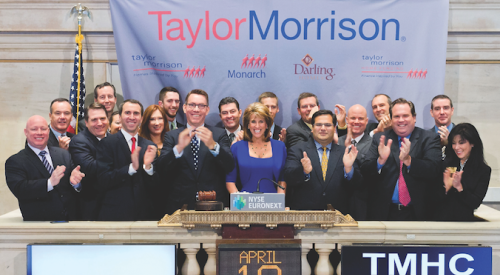|
New Jersey-based Hovnanian Enterprises is rocketing up the rankings of public home builders, thanks to the velvet touch of a leader who eschews the conventional strategy of concentrating production at the pricing mid-point in the top 50 housing markets. Instead, Ara Hovnanian recruits acquisition targets with a plan to operate in fewer markets — but dominate them — by turning local entrepreneurs loose in towns they know, with a new arsenal of housing products, national expertise and Wall Street capital.
Ara Hovnanian, 48, is a Yankee Doodle Dandy, born on the Fourth of July — in New Jersey, no less, one of the original 13 colonies. If George M. Cohan were around today, he might take that as a cue to cast Hovnanian, who has a voice like rumbling thunder, in the role of George Washington — or maybe Moses. But this is no actor. Along with those physical attributes, in the last year the Hovnanian Enterprises president and CEO has shown the intellect, strategic vision, persuasiveness, subtlety and grit of a natural born leader.
On back-to-back days in the first week of March this year, Hovnanian Enterprises announced the acquisition of Cambridge Homes (GIANT No.123), based in suburban Orlando, Fla., and Town & Country Homes (GIANT No.57), based in suburban Chicago. That got the attention of the entire housing industry, and Wall Street, because it puts Hovnanian in position to move past NVR into the No.6 spot in our GIANT 400 rankings.
Had those transactions taken place before the turn of the year, Hovnanian would have been ranked in this spring's GIANT 400 on 16,802 closings for $4.72 billion in 2004 revenue — well beyond NVR's 12,749 closings for $4.2 billion. Moreover, those acquisitions jack-hammered Hovnanian into two of this country's top 10 housing markets where it was previously not represented (Chicago and Orlando), while also adding strong positions in two other markets.
Local Market DominationIn one way, Hovnanian's recent acquisitions are deceptive. They lead a casual observer to conclude that positions in the top housing markets across the country are important to Hovnanian. That's not totally true. Ara Hovnanian does not want a small stake in many markets; he wants a significant share position in every market where his company operates, even if that means Hovnanian is not in as many markets as other large, national builders.
"We are much more interested in whether an acquisition target has a great management team than in the attributes of the new market," he says.
Hovnanian has become a very large builder, but it's not yet a threat to crack the ranks of the top five, the Supernovas who build in markets from coast to coast, and have closings in excess of 30,000 a year. To compete with such leviathans, Ara Hovnanian bases his strategy on a lesson he learned years ago in New Jersey: size is important locally more than nationally. Most of the attributes that come from size and scale flow to the biggest builder in town, not the biggest in the country.
"Long ago, we realized in our local New Jersey markets and suburban Philadelphia that even though Centex was a much larger company, its size was irrelevant in those local markets," Hovnanian says today. "To land sellers, subcontractors and home buyers, we were the ones who had the advantages of operational scale and name recognition."
That concept is the key to Hovnanian's strategy today. Rather than seek growth by spreading thinly into the top 50 housing markets, Hovnanian Enterprises plans to grow by adding dominant market share positions one at a time — positions that duplicate the advantage Hovnanian has as the big dog in New Jersey. The firm would rather land a dominant position in a second tier market than a minor one in the top 50.
Ara Hovnanian is all for growing market share, but he disdains gaining it via predatory pricing. "We don't buy market share," Hovnanian says. "We won't grow it at the expense of profitability. Size and scope create advantages that allow us to grow share and margins at the same time. To the extent we can find financially sound opportunities to expand our market share positions, we will.
"We are only in 17 states now, and in four of them we have scant presence. So a lot of the United States is wide open to us and we plan to expand our footprint, primarily through acquisitions."
Acquisitions Key ExpansionWhile he won't "buy" market share, Hovnanian is not against buying companies to acquire it. "Over the years, we've done both start-ups and acquisitions to enter new markets," Ara Hovnanian says. "We're better at acquisitions. We have an environment that is really conducive to entrepreneurs. We're entrepreneurial ourselves. We have a great track record of keeping all the senior managers in place in the firms we acquire."
Hovnanian says he wants to learn from every new management team and then spread that new knowledge across his whole company. And the flow of ideas inside a learning organization is one of the key sales pitches he makes to senior management teams to close an acquisition deal. "We find great chemistry in mixing local entrepreneurial talent with our capital and the product knowledge we have. Somewhere, we have expertise in a product type the local team may want to build," he says.
Hovnanian believes he can provide the capital and expertise that local teams needs to grow into new price points, product types and niches. "From active adult to urban infill, from elevatored mid-rises to high-rises, we have the knowledge to help local entrepreneurs expand market share by moving into products they've never offered before," he says.
No Fixer-UppersHovnanian claims 95 percent of senior managers of acquired firms stay on to build their careers inside his company. Part of the reason is that Hovnanian insists acquisitions have a track record of success and chemistry within the team. "We don't buy fixer-uppers," Hovnanian says. "We buy successful organizations that don't need radical changes. But we don't have a rigid set of processes and procedures that we impose on acquisitions. We don't box in entrepreneurs," he says. "We turn them loose to do the things they wanted to do, but didn't have the resources or knowledge to try."
Blackstone TrendsetterThe way the Town & Country acquisition was structured also marks Hovnanian as an industry leader. The builder brought in a New York-based investment fund — Blackstone Real Estate Advisors — as joint venture partners in Town & Country's existing residential communities. Blackstone will participate in the completion of those projects, but has no stake in future developments.
"We had the capital available to do the deal on our own, but this was a large transaction and we wanted to keep plenty of dry powder available in case something else became available," Hovnanian explains. "Company acquisitions also typically yield a lower financial return than organic acquisitions of land. So we want to balance acquisitions of companies with acquisition of land.
"And we take a very conservative approach to goodwill. We don't book any goodwill. So in order to avoid using a large chunk of our capital at lower returns, we decided combining our funding sources with those of Blackstone for this transaction made a lot of sense.
"I think we'll use this structure again, and — from talking to my peers — others are likely to use it as well. We're proud of the innovation."
Logic Behind StrategyAll public builders have a mandate from Wall Street to grow the top and bottom lines by double-digit percentages each year. Look at the market share those public builders already have in many of the top 50 housing markets across the country. Hovnanian's strategy to seek strong share positions in new markets suddenly makes a lot of sense. The fight for domination of the top markets is going to be brutal, and that makes Hovnanian's willingness to move into second-tier markets — as a dominant market leader — all the more prescient.
"In the top 25 markets, the 10 largest builders already have something like a 42 percent combined share of housing completions," Hovnanian says. "It's going to be hard for all the public builders to continue to grow 20 percent a year in the top markets. We think the ability to operate profitably in markets outside the top 50 will be critical."
Hovnanian Enterprises embraces this brave new world with the operational model it already has in place. And it's working right now.
| |||||||||||||||||||||||||||||||||||||||||












